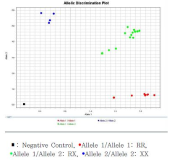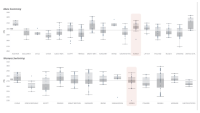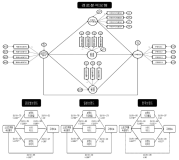The purpose of this research is to provide the information about sports injury by surveying and analyzing a result, and to lead analytic and scientific training among the subjects being elite summer sport athletes. All sports injuries are recorded on injury report form and the following results were obtained. In Cycle sport, the prevalence of injuries of the low back, knees were highest. and In Table tennis sport, the prevalence of injuries of the ankle was highest due to the chronic fatigue. The prevalence of injuries of the shoulder, low back were highest due to the overuse of joints. In Badminton sport, the prevalence of injuries of low back, knees, ankles were highest by overtraining. In Gymnastics, the prevalence of injuries of the low back, knees, ankles were highest. In Archery sport, there is a lot of injuries to the shoulder and neck. In Weight lifting sport, the prevalence of injuries of the low back, knees, and ankles were highest. In Golf sport, the prevalence of injuries of knees, low back were highest. In Hockey sport, the prevalence of injuries of ankles, knees, low back were highest. In Boxing sport, the prevalence of injuries of hands, shoulder, the low back were highest, In Judo sport, there are overall damage occurred in parts of the whole body, but the prevalence of injuries of ankles, knees, low back were highest. In Fencing sport, the prevalence of injuries of the low back, knees were highest. In Wrestling sport, although there is a difference slightly depending on freestyle and Greco-Roman, but the prevalence of injuries of knees, ankles, low back were highest. In Handball sport, the prevalence of injuries of ankles, knees were highest. In Taekwondo, the prevalence of injuries of ankles, knees, feet were highest.

The ACTN3 R577X polymorphism has been associated with an elite athletes status. Several studies have determined that the R allele is connected with power-oriented athletic performance, whereas the nonfunctional XX genotype may give some beneficial effect for endurance performance. The main aim of the study was to determine the possible interaction between the ACTN3 R577X polymorphism and an power-oriented athlete status in Korean elite athletes(wrestling 31, judo 13, boxing 16, fencing 6, cycle 16, ≤400m athlete 18). Each athletes performed a 30-second WAPtest with a resistance equal to 7.5% for male and 5% for female body weight. Genotyping for the ACTN3 R577X (rs1815739) polymorphism was performed using the TaqMan approach. The ACTN3 R577X genotypes exhibited a HardyWeinberg equilibrium distribution in our population. The relative and absolute average power results of the 30-second Wingate test did not differ significantly among the genotypes. However, the relative peak power result of the Wingate test was significantly higher in the R-allele- dominant model groups than in the XX group in male but not female athletes. These results suggest that the ACTN3 R allele is associated with the relative peak power during the Wingate test in male Korean elite athletes.


Purpose The purpose of this study was to compare the official world records of UIPM in the last 3 years to find out the relationship between the score characteristics of fencing, swimming, equestrian, and laser-run events in the final rankings and to analyze the relative importance of each event. Methods For 3 years, from 2017 to 2019, a total of the data were collected, the final rankings, fencing conversion scores, swimming conversion scores, equestrian scores, and laser-run conversion scores for all male and female athletes who participated in the UIPM Level 1 World Cup and World Championships(1,197 finals and 2,173 qualifiers). The Multiple regression analysis was used to establish the relationship between the response(subjective) variable and the conversion score of the four explanatory(independent) variables. Results The results were compared by qualification (n = 2173) and final (n = 1197) by dividing into male (n = 1179) and female (n = 1591), and the fencing score was qualifications (male β= -.691, female β= -.533) and the finals (male β= -.632, female β= -.632), it showed the greatest influence in all. On the other hand, the swim score showed the lowest impact on both qualifications (male β=-. 021, female β=-.196) and finals (male β=-. 087, female β=-. 207). The fencing event plays a major role in passing the qualifiers and is a big variable for good performance in the finals. On the other hand, in the case of swimming scores, both men and women had the lowest impact on the final ranking, and there is a limit to the final performance of swimming scores in both qualifiers. Conclusion In conclusion, it is necessary to analyze and systemize the fencing skills of the world’s best athletes, including Korean athletes, to improve the Korean fencing athletes' performance, and through such scientific analysis, a system that enables fast and flexible responses to the upcoming Olympic. Additionally, even though the importance of all sports should be levelled due to the characteristics of modern pentathlon, relative importance is biased toward fencing and swimming events are neglected. Therefore, it is deemed necessary to conduct a follow-up study on whether the scoring system in modern pentathlon consists of a scoring system that supports the records of each event and the upper and lower scoring system.





PURPOSE This study both validated the Characteristics of Resilience in Sports Teams Inventory (CREST) scale for use in Korean sports and analyzed the impact of team resilience on teamwork and performance. METHODS The study surveyed 462 elite football players by using the CREST scale to measure team resilience in Korean sports. Data were analyzed using descriptive statistics, exploratory factor analysis (EFA), reliability analysis, correlation analysis, multiple regression analysis, and confirmatory factor analysis (CFA). RESULTS First, results confirmed that the CREST scale’s two main factors—resilient characteristics and vulnerabilities under pressure—can be meaningfully applied in the Korean context. Second, resilient characteristics showed positive correlation with life skills, whereas vulnerabilities under pressure showed negative correlation. Third, resilient characteristics positively predicted life skills, whereas vulnerabilities under pressure negatively affected life skills. CONCLUSIONS The CREST scale was found reliable and valid in the Korean sports context, demonstrating that team resilience significantly impacts life skills. Thus, the study contributes to evaluation of resilience in Korean sports teams and provides strategicinsights to improve team performance.
The purpose of this study was to critically interpret a certain sports-related idea, "Integrated Korean Team," which was an issue at the PyeongChang Winter Olympics. The idea emerges as a specific political agenda under the conditions of domestic politics and the special environment of Korean national affairs and discourse. To this end, we investigated media texts on the relationship between sports, political dynamics and views on related discourse that were produced in 1990-1991 and 2018. The main findings are as follows: First, sports functions as a political socialization tool for political power as it forms public opinion. Second, sports exchanges work as a kind of international politics. Specifically, political power controls sports as certain political situations arise and political elites' needs change. Third, mega sports events have tended to become politicized in recent years as they become more effective. Fourth, North Korea’s sports under political power cannot be easily dealt with by the private sector, and it has limitations because it is not politically independent. The analysis showed that the negotiation process and realization of the Integrated North and South Korean Team seemed to be a turning point in politics and sports. Here are the conclusions drawn from discussing the two unifying events in 1991 and the situation in 2018. First, both South and North Korea pulled the Integrated Korean Team card when political needs arose. Second, when the two Koreas did not need to reconcile due to changes in the political situation between the two Koreas, they did not want to make efforts to integrate Korean Team. Third, the position of the political elite was directly represented by the position of the South-North Korean team. Fourth, the supporting public opinions of the Integrated Korean Team are gradually diminishing as the power gap between the two Koreas widens and sports players' human rights issues emerge.

The purpose of this study was to examine competitiveness of sport product companies by brand origin in the Korean market by analyzing attribute evaluation of sport products, brand equity, and purchase intention and their causal relationship. Competitive sport brands were selected in global, Japanese, and Korean brands by a pilot survey. Then, this study selected a population participating in sports for all, elite sports, professional sports, and leisure sports and 498 effective questionnaires were secured. As a result, Korean consumers for sport products evaluated global sport brands in the highest level, Japanese sport brands in the moderate level, and Korean sport brands in the lowest level in the evaluation of attribute evaluation of sport products, brand equity, and purchase intention. Moreover, the evaluation of participating types in sports for all, elite sports, professional sports, and leisure sports showed the same result in the order of global, Japanese, and Korean sport brands. Global sport brands had a sequential causal relationship from attribute evaluation of sport products to brand equity and purchase intention and formed a consumption behavior model that attribute evaluation of sport products led to purchase intention. On the other hand, while Korean sport brands had a sequential causal relationship from attribute evaluation of sport products to brand equity and purchase intention, attribute evaluation of sport products did not lead to purchase intention. Finally, it was confirmed that global brands such as Nike and Adidas had a high market position and Korean sport consumers’ purchase behavior was determined based on information of product attributes and brand equity.


PURPOSE This study aimed to examine the effects of motion analysis and image training using self-modeling with visual cues on the skill performance, imagery, and sports confidence of adolescent female soccer players. METHODS The participants were elite soccer players from two girls’ high school soccer teams divided into an experimental group (D girls’ high school, n=16) and a control group (I girls’ high school, n=13). The experimental group underwent motion analysis and image training when performing penalty kicks, short kicks, and long kicks using self-modeling with visual cues, while the control group underwent training using self-modeling videos without visual cues. Before and after the training, the evaluation score was calculated according to kick performance, and the imagery and sports confidence factors were measured. For the statistical analysis of all collected data, descriptive statistics, the Friedman test, the Mann-Whitney U test, and two-way repeated-measures analysis of variance were used. RESULTS First, on the motion analysis using self-modeling with visual cues, the experimental group’s penalty kick and short kick scores were improved and differed significantly, but no significant change was noted in long kick score. Second, as a result of image training using self-modeling with visual cues, all visual, kinesthetic, mood, and controllability factors of the experimental group improved except for the auditory factor, and the interaction effect was confirmed. In addition, the stated sports confidence of the experimental group was improved and the interaction effect confirmed. CONCLUSIONS The analysis of kick motion using self-modeling with visual cues was effective for the penalty kicks and short kicks of adolescent female soccer players. Moreover, this study confirmed that the analysis of kick motion improved the visual, kinesthetic, mood, and controllability sub-factors of imagery and significantly affected the players’ stated sports confidence.
Purpose The purpose of this study is to examine the socio-cultural background and the current issues of camp training system. This work could find the reason why camp training is continuing despite the regulatory policy. Methods This study compared past national and social situation, sports and education policies of each government, and the changes of sports paradigm through literature review. Results The settlement background of camp training system was explained by the national situation in 1970s and the elite sports policy. However, after the political democratization, the human rights ideology as universal value has developed, and the anti-human rights system which individuals sacrifice for the realization of community became not free in the school sports. Especially, since the 2000s, various social problems caused by camp training have been discussed and the school sports system is undergoing transition under various regulation. In this process, the conflict between the policy makers and the subjects is intensifying. The partial regulation, rather than radical reform, has been the cause of conflict without resolving 'the remnants of past elite sport policy'. The current regulation is limited to the "partial regulatory system", omitting fundamental changes such as the revision and abolition of the student-athletes' college entrance system. Conclusion This study presented two issues to normalize school sports. First, it is necessary to discuss the revision or abolishment of the student-athletes' college entrance system. Second, the existing school athletic system should be transformed into a future-oriented club system. By solving these problems, we can expect the policy effectiveness of current regulation and it will be able to reach the future that the regulatory policy are aiming at.
PURPOSE Players’ nonverbal behavior during a game may be expressed through selfregulatory and intentional processes, where nonverbal cues are strategically used to achieve specific outcomes. This study aimed to observe and explore the strategic and intentional nonverbal behaviors utilized by table tennis players. METHODS The study utilized a grounded theory methodology and involved purposeful sampling of ten adult table tennis players. Semi-structured face-to-face interviews were conducted. The collected data were analyzed using open, axial, and selective coding techniques. RESULTS The findings revealed that players’ intentional nonverbal behaviors are influenced by their confidence levels, physical condition, and perceptions of others’ nonverbal cues. Throughout this process, players underwent various emotional experiences, worked to maintain a positive mental state, and experienced changes in both their behaviors and psychological states, which impacted the flow of the game. CONCLUSIONS This study’s results provide valuable insights into the role of intentional nonverbal behaviors utilized by athletes during competitions. This suggests that understanding and incorporating intentional nonverbal behavior should be a key consideration in sports psychology counseling and psychological skills training.
Purpose Based on Haidt's social-intuitionist theory, this study analyzes the differences in ethical decision-making between sport athletes and the general public in order to understand the ethical judgment tendencies of athletes and examine the determining factors influencing their judgment from the perspective of their environment. In so doing, this study hopes to motivate education for enhancing ethical consciousness as well as institutional policy. Methods To this end, 200 elite athletes in their twenties registered for more than 10 years at the Korean Sports Association and 200 college students in their twenties from five universities in Seoul were selected for comparison. Response trends for each item were analyzed by percentage, and differences between groups were confirmed by the χ2 test method. Results The results are as follows. First, in general ethical situations, athletes usually showed a compulsory ethical view that emphasized principles, whereas in a sports situation, they showed a double consciousness and revealed a very strong consequential ethical view which put much emphasis on outcome. Second, athletes strongly maintained a Confucian ethical view that recognized ethics as a norm compared to the general public and, as a result, it was found that paternalism was relatively stronger than rationalism in their ethical decision making. Third, athletes regarded other people's thoughts and group interests as important criteria for ethical decision-making rather than individual thoughts and interests, and showed a group-centered mindset which emphasized group harmony and relationship. Fourth, while the general public viewed excellent athletes as those with excellent skills and good personality, and valued their morality, athletes thought relatively little of the influence and importance of morality in their success. Finally, it was found that coaches and managers were fundamental to the formation of the athlete’s moral view. Conclusion An in-depth understanding of sports participants' ethical awareness should come first in order to enhance ethical consciousness in sport. I hope this study will work as a catalyst for research which approaches athletes' ethical consciousness from a socio-cultural context.